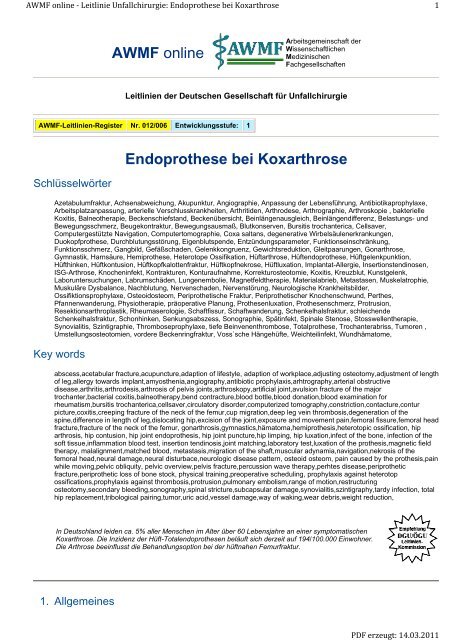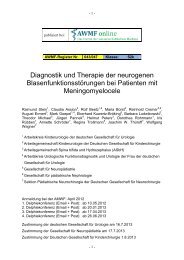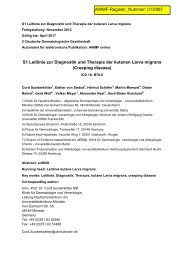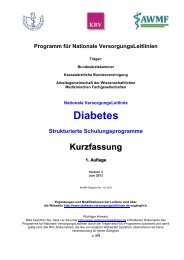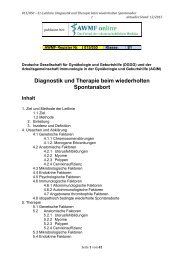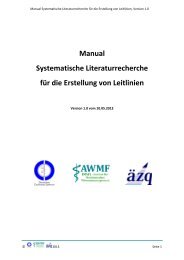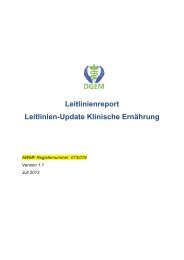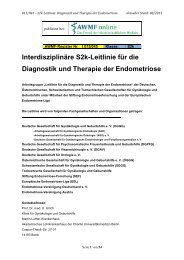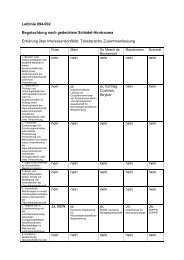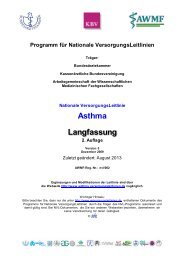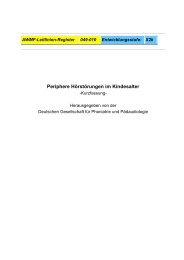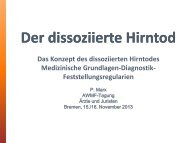Endoprothese bei Koxarthrose AWMF online
Endoprothese bei Koxarthrose AWMF online
Endoprothese bei Koxarthrose AWMF online
Erfolgreiche ePaper selbst erstellen
Machen Sie aus Ihren PDF Publikationen ein blätterbares Flipbook mit unserer einzigartigen Google optimierten e-Paper Software.
Schlüsselwörter<br />
Leitlinien der Deutschen Gesellschaft für Unfallchirurgie<br />
<strong>Endoprothese</strong> <strong>bei</strong> <strong>Koxarthrose</strong><br />
Azetabulumfraktur, Achsenabweichung, Akupunktur, Angiographie, Anpassung der Lebensführung, Antibiotikaprophylaxe,<br />
Ar<strong>bei</strong>tsplatzanpassung, arterielle Verschlusskrankheiten, Arthritiden, Arthrodese, Arthrographie, Arthroskopie , bakterielle<br />
Koxitis, Balneotherapie, Beckenschiefstand, Beckenübersicht, Beinlängenausgleich, Beinlängendifferenz, Belastungs- und<br />
Bewegungsschmerz, Beugekontraktur, Bewegungsausmaß, Blutkonserven, Bursitis trochanterica, Cellsaver,<br />
Computergestützte Navigation, Computertomographie, Coxa saltans, degenerative Wirbelsäulenerkrankungen,<br />
Duokopfprothese, Durchblutungsstörung, Eigenblutspende, Entzündungsparameter, Funktionseinschränkung,<br />
Funktionsschmerz, Gangbild, Gefäßschaden, Gelenkkongruenz, Gewichtsreduktion, Gleitpaarungen, Gonarthrose,<br />
Gymnastik, Harnsäure, Hemiprothese, Heterotope Ossifikation, Hüftarthrose, Hüftendoprothese, Hüftgelenkpunktion,<br />
Hüfthinken, Hüftkontusion, Hüftkopfkalottenfraktur, Hüftkopfnekrose, Hüftluxation, Implantat-Allergie, Insertionstendinosen,<br />
ISG-Arthrose, Knocheninfekt, Kontrakturen, Konturaufnahme, Korrekturosteotomie, Koxitis, Kreuzblut, Kunstgelenk,<br />
Laboruntersuchungen, Labrumschäden, Lungenembolie, Magnetfeldtherapie, Materialabrieb, Metastasen, Muskelatrophie,<br />
Muskuläre Dysbalance, Nachblutung, Nervenschaden, Nervenstörung, Neurologische Krankheitsbilder,<br />
Ossifiktionsprophylaxe, Osteoidosteom, Periprothetische Fraktur, Periprothetischer Knochenschwund, Perthes,<br />
Pfannenwanderung, Physiotherapie, präoperative Planung, Prothesenluxation, Prothesenschmerz, Protrusion,<br />
Resektionsarthroplastik, Rheumaserologie, Schaftfissur, Schaftwanderung, Schenkelhalsfraktur, schleichende<br />
Schenkelhalsfraktur, Schonhinken, Senkungsabszess, Sonographie, Spätinfekt, Spinale Stenose, Stosswellentherapie,<br />
Synovialitis, Szintigraphie, Thromboseprophylaxe, tiefe Beinvenenthrombose, Totalprothese, Trochanterabriss, Tumoren ,<br />
Umstellungsosteotomien, vordere Beckenringfraktur, Voss`sche Hängehüfte, Weichteilinfekt, Wundhämatome,<br />
Key words<br />
abscess,acetabular fracture,acupuncture,adaption of lifestyle, adaption of workplace,adjusting osteotomy,adjustment of length<br />
of leg,allergy towards implant,amyosthenia,angiography,antibiotic prophylaxis,arhtrography,arterial obstructive<br />
disease,arthritis,arthrodesis,arthrosis of pelvis joints,arthroskopy,artificial joint,avulsion fracture of the major<br />
trochanter,bacterial coxitis,balneotherapy,bend contracture,blood bottle,blood donation,blood examination for<br />
rheumatism,bursitis trochanterica,cellsaver,circulatory disorder,computerized tomography,constriction,contacture,contur<br />
picture,coxitis,creeping fracture of the neck of the femur,cup migration,deep leg vein thrombosis,degeneration of the<br />
spine,difference in length of leg,dislocating hip,excision of the joint,exposure and movement pain,femoral fissure,femoral head<br />
fracture,fracture of the neck of the femur, gonarthrosis,gymnastics,hämatoma,hemiprothesis,heterotopic ossification, hip<br />
arthrosis, hip contusion, hip joint endoprothesis, hip joint puncture,hip limping, hip luxation,infect of the bone, infection of the<br />
soft tissue,inflammation blood test, insertion tendinosis,joint matching,laboratory test,luxation of the prothesis,magnetic field<br />
therapy, malalignment,matched blood, metastasis,migration of the shaft,muscular adynamia,navigation,nekrosis of the<br />
femoral head,neural damage,neural disturbace,neurologic disease pattern, osteoid osteom, pain caused by the prothesis,pain<br />
while moving,pelvic obliquity, pelvic overview,pelvis fracture,percussion wave therapy,perhtes disease,periprothetic<br />
fracture,periprothetic loss of bone stock, physical training,preoperative scheduling, prophylaxis against heterotop<br />
ossifications,prophylaxis against thrombosis,protrusion,pulmonary embolism,range of motion,restructuring<br />
osteotomy,secondary bleeding,sonography,spinal stricture,subcapsular damage,synovialitis,szintigraphy,tardy infection, total<br />
hip replacement,tribological pairing,tumor,uric acid,vessel damage,way of waking,wear debris,weight reduction,<br />
1. Allgemeines<br />
<strong>AWMF</strong> <strong>online</strong><br />
<strong>AWMF</strong>-Leitlinien-Register Nr. 012/006 Entwicklungsstufe: 1<br />
<strong>AWMF</strong> <strong>online</strong> - Leitlinie Unfallchirurgie: Endopro 1<br />
Ar<strong>bei</strong>tsgemeinschaft der<br />
Wissenschaftlichen<br />
Medizinischen<br />
Fachgesellschaften<br />
In Deutschland leiden ca. 5% aller Menschen im Alter über 60 Lebensjahre an einer symptomatischen<br />
<strong>Koxarthrose</strong>. Die Inzidenz der Hüft-Totalendoprothesen beläuft sich derzeit auf 194/100.000 Einwohner.<br />
Die Arthrose beeinflusst die Behandlungsoption <strong>bei</strong> der hüftnahen Femurfraktur.<br />
PDF erzeugt: 14.03.2011
Die allgemeine Präambel für Unfallchirurgische Leitlinien ist integraler Bestandteil der vorliegenden Leitlinie. Die Leitlinie darf<br />
nicht ohne Berücksichtigung dieser Präambel angewandt, publiziert oder vervielfältigt werden. Ebenso ist die Methodik der<br />
Leitlinienentwicklung und der Konsensfindung in einem gesonderten Schriftsatz dargestellt.<br />
1.1. Ätiologie [3,14,19,31,39,45,50,57,61,74,75]<br />
� Posttraumatisch<br />
� Azetabulumfraktur<br />
� Hüftluxation<br />
� Hüftkopfkalottenfraktur<br />
� Hüftkopfkontusion<br />
� Schenkelhalsfraktur<br />
� Verletzung der Femurkopf versorgenden Gefäße<br />
� Achsfehlstellungen nach Frakturen<br />
� Angeborene Fehlbildungen des Hüftgelenkes<br />
� Pfannendeformität<br />
� Dysplasie<br />
� Schenkelhalsfehlstellung<br />
� Coxa valga<br />
� Coxa vara<br />
� Coxa antetorta<br />
� Hüftkopfdeformität<br />
� Erworbene Deformitäten<br />
� Morbus Perthes<br />
� Epiphysiolyse<br />
� Entzündliche Erkrankungen des Hüftgelenkes<br />
� Bakterielle und andere Erreger<br />
� rheumatische Erkrankungen<br />
� Stoffwechselerkrankungen<br />
� Hüftkopfnekrosen<br />
� posttraumatisch<br />
� medikamentös<br />
� alkoholtoxisch<br />
� renal<br />
� Caissonkrankheit<br />
� unklare Ursachen (idiopathisch)<br />
1.2. Prävention<br />
� Wiederherstellung der Gelenkkongruenz nach Verletzungen<br />
� Adäquate Therapie <strong>bei</strong> Schenkelhalsfraktur (Siehe Leitlinie Schenkelhalsfraktur)<br />
� ausreichend lange Entlastung <strong>bei</strong> beginnender Hüftkopfnekrose<br />
� Frühzeitige Diagnostik <strong>bei</strong> schwerer symptomatischer Hüftkontusion<br />
� Frühe Therapie <strong>bei</strong> Hüftdysplasie<br />
� Stufenweise Belastungssteigerung <strong>bei</strong> hüftbelastenden Sportarten (Marathonlaufen)<br />
� Korrekturosteotomie<br />
� Kopferhaltende indirekte rekonstruktive Eingriffe (Hüftkopf, Hüftpfanne)<br />
� Osteochondrale rekonstruktive Eingriffe<br />
1.3. Lokalisation<br />
� Hüftgelenk<br />
1.4. Typische Begleitverletzungen<br />
� entfällt<br />
1.5. Klassifikation [58]<br />
� Klinische Scores der <strong>Koxarthrose</strong><br />
� Larson IOWA HipScore(1963)<br />
� Harris(1969)<br />
<strong>AWMF</strong> <strong>online</strong> - Leitlinie Unfallchirurgie: Endopro 2<br />
PDF erzeugt: 14.03.2011
� Merle d'Aubigne(1949)<br />
� Postel(1954)<br />
� Wilson HSS(1972)<br />
� Röntgenologische Scores der <strong>Koxarthrose</strong><br />
� Kellgren und Lawrence (1963)<br />
Grad0 keine Veränderungen<br />
Grad1 fragliche Gelenkspaltverschmälerung, fragliche Osteophyten<br />
Grad2 Eindeutige Osteophyten, eindeutigeGelenkspaltverschmälerung, leichte Sklerose;<br />
Grad3 Fortgeschrittene Gelenkspaltverschmälerung, Osteophyten, leichte Sklerose und Cystenbildung,<br />
leichte Deformierung von Hüftkopf und Acetabulum<br />
Grad4 Weitgehende Aufhebung des Gelenkspaltes mit Sklerose und Zysten, deutliche Deformierung von<br />
Hüftkopf und Acetabulum, große Osteophyten<br />
� Harris (1969)<br />
Grad I : Gelenkspaltverschmälerung<br />
Grad II : Osteophytenbildung<br />
Grad III : Pfannendach- und Hüftkopfzysten<br />
Grad IV : Ankylose<br />
2. Präklinisches Management<br />
2.1. Analyse der Unfallherganges<br />
� entfällt<br />
2.2. Notfallmaßnahmen<br />
� entfällt<br />
2.3. Dokumentation<br />
� entfällt<br />
3. Anamnese<br />
3.1. Analyse des Krankheitsbildes<br />
� Verlust an Lebensqualität<br />
� Einschränkung der Mobilität<br />
� Einschränkung der Gelenkbeweglichkeit<br />
� Schmerzfreies Gehen<br />
� Gehstrecke<br />
� Gehdauer<br />
� Schmerz<br />
� Lokalisation<br />
� Zeitpunkt des Auftretens und nach Art der Beanspruchung<br />
� Intensität<br />
� Häufigkeit<br />
� Qualität<br />
� Medikamenteneinnahme auf Grund der Schmerzen<br />
� Bisherige Therapie<br />
3.2. Gesetzliche Unfallversicherung<br />
<strong>AWMF</strong> <strong>online</strong> - Leitlinie Unfallchirurgie: Endopro 3<br />
� In Deutschland muss <strong>bei</strong> allen Ar<strong>bei</strong>tsunfällen, <strong>bei</strong> Unfällen auf dem Weg von und zur Ar<strong>bei</strong>t sowie <strong>bei</strong> Unfällen in<br />
Zusammenhang mit Studium, Schule und Kindergarten sowie allen anderen gesetzlich versicherten Tätigkeiten eine<br />
Unfallmeldung durch den Ar<strong>bei</strong>tgeber erfolgen, wenn der Unfall einer Ar<strong>bei</strong>tsunfähigkeit von mehr als 3 Kalendertagen<br />
oder den Tod zur Folge hat. In Österreich muss diese Meldung in jedem Fall erfolgen. Diese Patienten müssen in<br />
Deutschland einem zum Durchgangsarztverfahren oder H-Arzt-Verfahren zugelassenen Arzt vorgestellt werden.<br />
� In Fällen, in denen eine Verletzung nach den Verletzungsartenverzeichnis der gesetzlichen Unfallversicherer vorliegt,<br />
hat der behandelnde Arzt in Deutschland dafür zu sorgen, dass der Unfallverletzte unverzüglich in ein von den<br />
Landesverbänden der Deutschen Gesetzlichen Unfallversicherung (DGUV) am Verletzungsartenverfahren (VAV)<br />
beteiligtes Krankenhaus überwiesen wird (§37,1 Vertrag Ärzte/UV-Träger: Verletzungsartenverfahren).<br />
� Die in dieser Leitlinie zur Frage stehende, einer Coxarthrose zu Grunde liegende Verletzung unterliegt dem<br />
Verletzungsartenverfahren (VAV).<br />
PDF erzeugt: 14.03.2011
3.3. Vorerkrankungen und Verletzungen [39,74]<br />
� Posttraumatisch<br />
Azetabulumfraktur<br />
Hüftluxation<br />
Hüftkopfkalottenfraktur<br />
Hüftkopfkontusion<br />
Schenkelhalsfraktur Verletzung der Femurkopf versorgenden Gefäße<br />
Achsfehlstellungen nach Frakturen<br />
� Osteoporose und andere Knochenstoffwechselkrankheiten<br />
� Tumorerkrankungen (erhöhtes Thromboserisiko)<br />
� Herz-Kreislauferkrankungen<br />
� Neurologische Erkrankungen<br />
� <strong>Koxarthrose</strong> der Gegenseite<br />
� Gelenkersatz an anderen Gelenken<br />
� Einschränkungen und Vorerkrankungen angrenzender Gelenke, auch der Gegenseite<br />
� Vorbestehende Achsabweichungen untere Extremität<br />
3.4. Wichtige Begleitumstände [32]<br />
� Voroperationen am Hüftgelenk<br />
� Intraartikuläre Injektionen<br />
� Tumorerkrankungen oder Metastasen an der betroffenen Extremität<br />
� Vorausgegangene Thrombosen und Embolien<br />
� Vorausgegangene gefäßchirurgische Eingriffe<br />
� Einnahme gerinnungsrelevanter Medikamente (z.B. ASS, Hormonsubstitution)<br />
� Metformin<br />
� Einnahme knochenstoffwechsel beeinflussender Medikamente (z.B. Cortison)<br />
� Allergien<br />
� Adipositas<br />
� Beinlängendifferenz<br />
� Beinachsenveränderungen<br />
� Rezidivierende Harnwegsinfekte<br />
� Dialysepflichtigkeit<br />
3.5. Symptome<br />
� Anlaufschmerz<br />
� Knieschmerz<br />
� Belastungs- und Bewegungsschmerz des Hüftgelenkes<br />
� Funktionseinschränkung (Rotation ,Abduktion, Flektion)<br />
� Gelenkkontraktur (meist Beugekontraktur)<br />
� Schonhinken<br />
� Muskelatrophie<br />
� Ruheschmerz<br />
� Rückenschmerz<br />
4. Diagnostik<br />
4.1. Notwendig<br />
� Klinische Untersuchung<br />
� Gangbild<br />
� Bewegungsausmaß (Gelenkkontraktur beachten)<br />
� Funktionsschmerz<br />
� Beinlängendifferenz<br />
� Beinachsen<br />
� Beckenschiefstand<br />
� Narbe nach Voroperationen<br />
� Wirbelsäule und Ileosakralgelenke,<br />
� Gelenke <strong>bei</strong>der unterer Extremitäten<br />
� Muskulärer Zustand<br />
� Motorik und Sensibilität<br />
� Durchblutungsstörungen arteriell und venös<br />
� Bruchpforten<br />
� Infektzeichen (lokal , regional , allgemein)<br />
� Pilzbefall (inguinal, interdigital)<br />
� Weichteilverhältnisse im Operationsgebiet und an der Extremität<br />
� Labor<br />
<strong>AWMF</strong> <strong>online</strong> - Leitlinie Unfallchirurgie: Endopro 4<br />
PDF erzeugt: 14.03.2011
� Laboruntersuchungen unter Berücksichtigung von Alter und Begleiterkrankungen des Patienten<br />
� Entzündungsparameter<br />
� Kreuzblut für Blutgruppe und Blutkonserven<br />
� Abklärung der Möglichkeit und ggf. Einleitung einer Eigenblutspende<br />
� Ausschluss Hepatitis und HIV Infektion<br />
� Ausschluss Harnwegsinfekt<br />
� Röntgenuntersuchung<br />
� Beckenübersicht tief eingestellt exakt a. p.<br />
� Betroffene Hüfte tief axial oder Lauenstein-Projektion<br />
4.2. Fakulativ<br />
� Labor<br />
� Rheumaserologie<br />
� Harnsäure<br />
� Densitometrie<br />
� Bildgebende Verfahren<br />
� CT<br />
� MRT<br />
� Konturaufnahme (faux profile)<br />
� Beinachsenaufnahmen<br />
� Röntgenuntersuchung gesamtes Femur, Knie und Lendenwirbelsäule<br />
4.3. Ausnahmsweise<br />
� Hüftgelenkpunktion<br />
� Arthroskopie<br />
� Bildgebende Verfahren<br />
� Angiographie<br />
� Szintigraphie<br />
� Sonographie<br />
� Röntgentomographie<br />
4.4. Nicht erforderlich<br />
� Arthrographie<br />
4.5. Diagnostische Schwierigkeiten<br />
� Interpretation hüftbedingter, ausstrahlender Knie- und Leistenschmerzen<br />
� Spinale Stenose<br />
� Degenerative Wirbelsäulenschäden<br />
� Radikuläre Schmerzen<br />
� Bandscheibenschäden<br />
� Ileosakralgelenk- Arthrose<br />
4.6. Differentialdiagnose<br />
� Schleichende Schenkelhalsfraktur<br />
� Vordere Beckenringfraktur<br />
� Beginnende Hüftkopfnekrose<br />
� Bursitis trochanterica<br />
� Insertionstendinosen<br />
� Coxa saltans<br />
� Inguinalhernie/ Schenkelhernie<br />
� Bursa/Bursitis ileopectinea<br />
� Gonarthrose<br />
� Degenerative Wirbelsäulenerkrankungen<br />
� ISG-Arthrose<br />
� Koxitis<br />
� Labrumschäden am Acetabulum<br />
� Osteoidosteom<br />
� Arthritiden<br />
� Heterotope Ossifikationen<br />
� Neurologische Krankheitsbilder<br />
� Arterielle Verschlusskrankheiten<br />
� Senkungsabszess<br />
� Tumoren , Metastasen<br />
<strong>AWMF</strong> <strong>online</strong> - Leitlinie Unfallchirurgie: Endopro 5<br />
PDF erzeugt: 14.03.2011
5. Klinische Erstversorgung<br />
5.1. Klinisches Management<br />
entfällt<br />
5.2. Allgemeine Maßnahmen<br />
entfällt<br />
5.3. Spezielle Maßnahmen<br />
entfällt<br />
6. Indikation zur definitiven Therapie<br />
6.1. Nicht operativ<br />
� Geringer Leidensdruck<br />
� Geringe Einschränkung der Funktion<br />
� Gutes Ansprechen auf konservative Behandlung<br />
� Allgemeine oder lokale Kontraindikationen gegen eine Operation<br />
� Hohes Narkoserisiko<br />
� Mangelnde Compliance zur endoprothetischen Versorgung<br />
6.2. Operativ<br />
Radiologische Coxarthrosezeichen sind immer in Relation zum subjektiven Leidensdruck und zum klinischen<br />
Untersuchungsbefund für die Indikationsstellung zu interpretieren.<br />
� Hoher Leidensdruck<br />
� Verlust an Lebensqualität<br />
� starker Schmerz oder Dauerschmerz<br />
� schwere Bewegungseinschränkung, Beugekontraktur<br />
� erhebliche Einschränkung der Gehstrecke (
7.2. Begleitende Maßnahmen<br />
� Klinische und radiologische Kontrolluntersuchungen im Abstand von sechs bis zwölf Monaten in Abhängigkeit vom<br />
Beschwerdebild<br />
� Laborkontrollen entsprechend medikamentöser Nebenwirkungen oder Ätiologie<br />
7.3. Häufigste Verfahren<br />
� Medikamentös<br />
� Physiotherapie<br />
� Balneotherapie<br />
� Heilsport und Gymnastik<br />
� Gewichtsreduktion<br />
� Beinlängenausgleich<br />
� Ar<strong>bei</strong>tsplatzanpassung<br />
� Anpassung der Lebensführung<br />
� Spezielle Hüftschule<br />
7.4. Alternativverfahren<br />
� entfällt<br />
7.5. Seltene Verfahren<br />
� medikamentös intraartikulär<br />
� Akupunktur<br />
� Stosswellentherapie<br />
7.6. Zeitpunkt<br />
� beschwerdeabhängig<br />
� abhängig von Begleiterkrankungen<br />
7.7. Weitere Behandlung<br />
� <strong>bei</strong> Zunahme der Beschwerden und/oder Funktionseinschränkung oder dauernde Medikamentenabhängigkeit<br />
operative Therapie<br />
7.8. Risiken und Komplikationen<br />
� Medikamentennebenwirkungen<br />
� Schmerzmittelsucht<br />
� Sekundäre degenerative Wirbelsäulenschäden<br />
� Muskelatrophien<br />
� Kontrakturen<br />
� Protrusio acetabuli<br />
8. Therapie operativ<br />
8.1. Logistik [1,7,17]<br />
� Voraussetzungen für eine fachgerechte präoperative Planung<br />
� Möglichkeiten fremdblutsparender Maßnahmen (z.B. Eigenblutspende, Cellsaver)<br />
� Spezialinstrumente<br />
� Geeigneter Operationstisch<br />
� Dem Verfahren angepasste Lagerungsmöglichkeiten<br />
� Implantate in adäquater Größe und Anzahl<br />
� Instrumente und Implantate zur Beherrschung intraoperativer Komplikationen<br />
� Möglichkeit intraoperativer Röntgen/Durchleuchtungskontrolle<br />
� Sicherstellung eventuell notwendiger intensivmedizinischer Behandlung postoperative<br />
8.2. Perioperative Maßnahmen [34,56,59,68,69]<br />
<strong>AWMF</strong> <strong>online</strong> - Leitlinie Unfallchirurgie: Endopro 7<br />
� zeitgerechte Aufklärung über die Operation und deren mögliche Alternativverfahren sowie über Risiken und Prognose<br />
� Präoperative Planung anhand standardisierter Röntgenbilder<br />
� Sanierung bakterieller Streuherde (lokal, regional und systemisch)<br />
� Sanierung eines Harnwegsinfektes<br />
PDF erzeugt: 14.03.2011
� Thromboseprophylaxe (siehe interdisziplinäre Leitlinie)<br />
� Antibiotikaprophylaxe systemisch und/oder lokal(antibiotikahaltiger Knochenzement )<br />
� Physiotherapie und Gangschulung (<strong>bei</strong> Bedarf auch präoperativ)<br />
� Ossifikationsprophylaxe <strong>bei</strong> erhöhtem Risiko heterotoper Verkalkungen<br />
8.3. Häufigste Verfahren [2,4,5,8,9,10,15,16,20,22,25,27,33,35,36,40,65,66,77,87,88,91,92]<br />
� totaler Ersatz des Hüftgelenkes ( Hüftkopf und Hüftpfanne )<br />
� zementierte Implantationstechnik<br />
� zementfreie Implantationstechnik<br />
� Hybride Implantationstechnik, ( meist Schaftkomponente zementiert, selten Pfanne)<br />
� Gleitpaarungen <strong>bei</strong> Totalendoprothesen<br />
� Keramik/Polyäthylen<br />
� Metall/Polyäthylen<br />
� Metall/Metall<br />
� Keramik/Keramik<br />
Es gibt eine Vielzahl verschiedener Formen, Materialien und Oberflächen für Schaft, Pfanne und Kopf.<br />
8.4. Alternativverfahren [11,53,80,90,93]<br />
� Umstellungsosteotomien<br />
� Hemiprothesen <strong>bei</strong> intaktem Azetabulum<br />
� Minimalinvasive Implantationstechnik<br />
� Oberflächenersatz<br />
8.5. Seltene Verfahren [29]<br />
� Arthrodese des Hüftgelenkes<br />
� Voss`sche Hängehüfte<br />
� Resektionsarthroplastik (Girdlestone-Situation)<br />
� Navigationsgestützte Implantationstechnik<br />
8.6. Operationszeitpunkt [54]<br />
� Wahleingriff abhängig vom Beschwerdebild des Patienten<br />
8.7. Postoperative Behandlung [12,70]<br />
� Rotationssichernde Lagerung des operierten Beines<br />
� Keine dauerhafte Beugestellung der Hüfte (Kontrakturvorbeugung)<br />
� Röntgenkontrolle (tiefe Einstellung und Hüfte axial)<br />
Cave: Luxationsgefahr <strong>bei</strong> Lauenstein-Technik<br />
� Frühmobilisation<br />
� Thromboseprophylaxe entsprechend der interdisziplinären Leitlinie<br />
� Laborkontrollen<br />
� Regelmäßige Wundkontrollen<br />
� Belastung individuell<br />
� Physiotherapie , Gangschulung<br />
� Prothesenpass<br />
8.8. Risiken und Frühkomplikationen [28,30,38,71,76]<br />
� Allgemeine Risiken<br />
� Tiefe Beinvenenthrombose (ohne Thromboseprophylaxe 45-57%)<br />
� Lungenembolie (ohne Thromboseprophylaxe 6%)<br />
Unter Thromboembolie-Prophylaxe liegt die asymptomatische Thromboserate in der Größenordnung 18% für<br />
niedermolekulares Heparin, 21% für pneumatische Kompression, 23 % für Kumarine und 31% für Azetylsalizylsäure.<br />
� Wundhämatome<br />
� Weichteilinfekte<br />
� Knocheninfekte<br />
� Nachblutungen<br />
� Nervenschäden<br />
� Gefäßschäden<br />
� Unverträglichkeiten durch Fremdblutgabe<br />
� Spezielle Risiken<br />
<strong>AWMF</strong> <strong>online</strong> - Leitlinie Unfallchirurgie: Endopro 8<br />
PDF erzeugt: 14.03.2011
� Schmerzen<br />
� Beinlängendifferenzen<br />
� Prothesenluxation<br />
� Beinachsenabweichung<br />
� Schaftfissur , -fraktur , -perforation<br />
� Bewegungseinschränkung<br />
� Allergie<br />
� Hüfthinken (Trendelenburg-Zeichen)<br />
� Trochanter major-Fraktur<br />
� Blutverlust<br />
� Geräuschentwicklung <strong>bei</strong> Keramik-Keramik-Gleitpaarung<br />
9. Weiterbehandlung<br />
9.1. Rehabilitation<br />
� Physiotherapie<br />
� Gangschulung<br />
� Verhaltensmassregeln<br />
� Anziehhilfen<br />
� Hilfsmittel (Toilettenaufsatz)<br />
� Fortführung der medikamentösen Thromboseprophylaxe entsprechend der interdisziplinären Leitlinie<br />
9.2. Kontrollen [26]<br />
� Regelmäßige, langjährige klinische und radiologische Kontrollen<br />
� Wiederaufnahme der Diagnostik <strong>bei</strong> erneut auftretenden Beschwerden<br />
9.3. Implantatentfernung<br />
� zusätzlich eingebrachte Implantate im Einzelfall<br />
9.4. Spätkomplikationen [24,41,44,46,47,49,64]<br />
� Prothesenschmerz<br />
� Bewegungseinschränkung<br />
� Spätinfekt<br />
� Prothesenlockerung<br />
� Prothesenluxation<br />
� Pfannenmigration/Protrusion<br />
� Schaftwanderung<br />
� Knochenverlust (stress-shielding)<br />
� Implantatausbruch<br />
� Implantatversagen<br />
� Materialabrieb<br />
� Synovialitis<br />
� Periprothetische Fraktur<br />
� Insertionstendinosen<br />
� Heterotope paraartikuläre Ossifikation<br />
� Sekundäre Wirbelsäulenfehlstellung<br />
9.5. Dauerfolgen [60,89]<br />
� Chronische Lockerung<br />
� Beinlängendifferenz<br />
� Beckenschiefstand<br />
� Muskuläre Dysbalance<br />
� Bewegungseinschränkung<br />
� Periprothetischer Knochenschwund<br />
10. Klinisch-wissensschaftliche Scores [37]<br />
� Harris (1969 )<br />
� Merle d`Aubigné ( 1949 )<br />
� Postel ( 1954 )<br />
� Wilson HSS ( 1972 )<br />
11. Prognose<br />
<strong>AWMF</strong> <strong>online</strong> - Leitlinie Unfallchirurgie: Endopro 9<br />
PDF erzeugt: 14.03.2011
[6,13,18,21,23,42,43,48,51,52,55,62,63,67,72,73,78,79,81,82,83,84,85,86,94]<br />
� In der Regel wird eine verbesserte Funktion und weitgehende Schmerzreduktion erreicht<br />
� Durchschnittliche Haltbarkeit zementierter und zementfreier Hüftendoprothesen zehn bis fünfzehn Jahre , in<br />
Abhängigkeit von Biomechanik, Alter , Aktivität , Gewicht , Knochenqualität u.a.m.<br />
12. Prävention von Folgeschäden<br />
Literatur:<br />
� sorgsamer Umgang mit dem Kunstgelenk<br />
� Vermeidung von übermäßiger Beanspruchung im Sport<br />
� Vermeidung extrem körperlich belastender Situationen<br />
� Regelmäßige Kontrolluntersuchungen<br />
� Bei Infektionen aller Art, Herdinfekten und deren Sanierung immer Antibiotikatherapie<br />
� Vermeidung osteoporose-induzierender Medikamente<br />
� Gewichtskontrolle<br />
Siehe auch unter Bibliographie der Leitlinie "Prothesenwechsel am Hüftgelenk" 012-007.htm<br />
<strong>AWMF</strong> <strong>online</strong> - Leitlinie Unfallchirurgie: Endopro 10<br />
1. Aebi M, Richner L, Ganz R[Long-term results of primary hip total prosthesis with acetabulum<br />
reinforcement ring]Orthopade 1989, 18(6) p504-10<br />
2. Alexiades MM, Clain MR, Bronson MJProspective study of porous-coated anatomic total hip<br />
arthroplasty.Clin Orthop (269) p205-8<br />
3. Andress HJ, Forkel H, Grubwinkler M, et al.[Treatment of per- and subtrochanteric femoral fractures by<br />
gamma nails and modular hip prostheses. Differential indications and results]Unfallchirurg 103(6) p444-<br />
51<br />
4. Archibeck MJ, Berger RA, Jacobs JJ, et al.Second-generation cementless total hip arthroplasty. Eight to<br />
eleven-year results.J Bone Joint Surg Am 2001, 83-A(11) p1666-73<br />
5. Archibeck MJ, Rosenberg AG, Berger RA, et al.Trochanteric osteotomy and fixation during total hip<br />
arthroplasty.J Am Acad Orthop Surg 2003, 11(3) p163-73<br />
6. Arnold P, Schule B, Schroeder-Boersch H, et al.[Review of the results of the ARO multicenter study]<br />
Orthopade 1998, 27(6) p324-32<br />
7. Bang-Vojdanovski B, Trager D, Siebert W[Autologous transfusion in total hip endoprosthesis--a clinical<br />
concept]Z Orthop Ihre Grenzgeb 1997, 135(3) p252-7<br />
8. Bauer TW, Stulberg BN, Ming J, et al.Uncemented acetabular components. Histologic analysis of<br />
retrieved hydroxyapatite-coated and porous implants.J Arthroplasty 1993, 8(2) p167-77<br />
9. Bereiter H, Burgi M, Rahn BA[The temporal behavior of the anchorage of a cement-free implanted<br />
acetabular cup in animal experiments]Orthopade 1992, 21(1) p63-70<br />
10. Berger RA, Jacobs JJ, Quigley LR, et al.Primary cementless acetabular reconstruction in patients<br />
younger than 50 years old. 7- to 11-year results.Clin Orthop 1997, (344) p216-26<br />
11. Berger RATotal hip arthroplasty using the minimally invasive two-incision approach.Clin Orthop Relat<br />
Res 2003, (417) p232-41<br />
12. Bergmann G, Rohlmann A, Graichen F[In vivo measurement of hip joint stress. 1. Physical therapy]Z<br />
Orthop Ihre Grenzgeb 1989, 127(6) p672-9<br />
13. Berry DJ, Harmsen WS, Ilstrup DMThe natural history of debonding of the femoral component from the<br />
cement and its effect on long-term survival of Charnley total hip replacements.J Bone Joint Surg Am<br />
1998, 80(5) p715-21<br />
14. Bisla RS, Ranawat CS, Inglis AETotal hip replacement in patients with ankylosing spondylitis with<br />
involvement of the hip.J Bone Joint Surg Am 1976, 58(2) p233-8<br />
15. Breusch SJ, Aldinger PR, Thomsen M, et al.[Anchoring principles in hip prosthesis implantation. II:<br />
Acetabulum components]Unfallchirurg 2000, 103(12) p1017-31<br />
16. Breusch SJ, Aldinger PR, Thomsen M, et al.[Anchoring principles in hip endoprostheses. I: Prosthesis<br />
stem]Unfallchirurg 2000, 103(11) p918-31<br />
17. Breusch SJ, Reitzel T, Schneider U, et al.[Cemented hip prosthesis implantation--decreasing the rate of<br />
fat embolism with pulsed pressure lavage]Orthopade 2000, 29(6) p578-86<br />
18. Britton AR, Murray DW, Bulstrode CJ, et al.Long-term comparison of Charnley and Stanmore design<br />
total hip replacements.J Bone Joint Surg Br 1996, 78(5) p802-8<br />
19. Buttner-Janz K, Jessen N, Hommel H[Acetabular component implantation in coxarthrosis due to<br />
dysplasia after high congenital hip dislocation]Chirurg 2000, 71(11) p1374-9<br />
20. Cannestra VP, Berger RA, Quigley LR, et al.Hybrid total hip arthroplasty with a precoated offset stem.<br />
PDF erzeugt: 14.03.2011
<strong>AWMF</strong> <strong>online</strong> - Leitlinie Unfallchirurgie: Endopro 11<br />
Four to nine-year results.J Bone Joint Surg Am 2000, 82(9) p1291-9<br />
21. Cracchiolo A, Severt R, Moreland JUncemented total hip arthroplasty in rheumatoid arthritis diseases. A<br />
two- to six-year follow-up study.Clin Orthop 1992, (277) p166-74<br />
22. Demuynck M, Haentjens P, De Valkeneer O, et al.Total hip arthroplasty with the porous-coated anatomic<br />
(PCA) prosthesis: the acetabular component.Acta Orthop Belg 1993, 59 Suppl 1 p304-6<br />
23. Dick W, Elke R[Hip prosthesis implantation--only good long-term results count!]Orthopade 2001, 30(5)<br />
p257<br />
24. Dominkus M, Morscher M, Beran G, et al.[Analysis of acetabulum migration in rheumatoid arthritis<br />
compared with cementless acetabular revision]Orthopade 1998, 27(6) p349-53<br />
25. Effenberger H, Lassmann S, Hilzensauer G, et al.[Cementless hip prosthesis in patients with rheumatoid<br />
arthritis]Orthopade 1998, 27(6) p354-65<br />
26. Effenberger H, Mechtler R, Jerosch J, et al.[Quality management in hip and knee prosthesis<br />
implantation]Orthopade 2001, 30(5) p332-44<br />
27. Eingartner C, Ihm A, Maurer F, et al.[Good long term results with a cemented straight femoral shaft<br />
prosthesis made of titanium]Unfallchirurg 2002, 105(9) p804-10<br />
28. Eisele R, Strecker W, Gfrorer W, et al.[Intramedullary pressure reduction in the femur shaft in total hip<br />
endoprosthesis. Effect on the rate of thrombosis]Unfallchirurg 1997, 100(6) p438-42<br />
29. Esenwein SA, Robert K, Kollig E, et al.[Long-term results after resection arthroplasty according to<br />
Girdlestone for treatment of persisting infections of the hip joint]Chirurg 2001, 72(11) p1336-43<br />
30. Fabian W, Dereser A[Early complications and their causes in prosthetic hip joint replacement for<br />
coxarthrosis or median femoral neck fracture. Retrospective study of 3613 implanted hip joints]Aktuelle<br />
Traumatol 1991, 21(6) p250-60<br />
31. Fink B, Ruther W[Partial and total joint replacement in femur head necrosis]Orthopade 2000, 29(5) p449-<br />
56<br />
32. Freiberg AA, Cantor R, Freiberg RAThe use of aspirin to prevent heterotopic ossification after total hip<br />
arthroplasty. A preliminary report.Clin Orthop 1991, (267) p93-6<br />
33. Fye MA, Huo MH, Zatorski LE, et al.Total hip arthroplasty performed without cement in patients with<br />
femoral head osteonecrosis who are less than 50 years old.J Arthroplasty 1998, 13(8) p876-81<br />
34. Gebuhr P, Soelberg M, Orsnes T, et al.Naproxen prevention of heterotopic ossification after hip<br />
arthroplasty. A prospective control study of 55 patients.Acta Orthop Scand 1991, 62(3) p226-9<br />
35. Goldberg VMAnatomic cementless total hip replacement: design considerations and early clinical<br />
experience.Acta Orthop Belg 1993, 59 Suppl 1 p183-9<br />
36. Goldberg VM, Ninomiya J, Kelly G, et al.Hybrid total hip arthroplasty: a 7- to 11-year followup.Clin Orthop<br />
1996, (333) p147-54<br />
37. Harris WHTraumatic arthritis of the hip after dislocation and acetabular fractures: treatment by mold<br />
arthroplasty. An end-result study using a new method of result evaluation.J Bone Joint Surg Am 1969, 51<br />
(4) p737-55<br />
38. Heisel C, Mau H, Borchers T, et al.[Fat embolism during total hip arthroplasty. Cementless versus<br />
cemented--a quantitative in vivo comparison in an animal model]Orthopade 2003, 32(3) p247-52<br />
39. Hessmann MH, Nijs S, Rommens PM[Acetabular fractures in the elderly. Results of a sophisticated<br />
treatment concept]Unfallchirurg 2002, 105(10) p893-900<br />
40. Howard MB, Bruce WJ, Walsh W, et al.Total hip arthroplasty for arthrodesed hips.J Orthop Surg 2002,<br />
10(1) p29-33<br />
41. Hu HP, Slooff TJ, van Horn JRHeterotopic ossification following total hip arthroplasty: a review.Acta<br />
Orthop Belg 1991, 57(2) p169-82<br />
42. Hungerford DS, Krackow KA, Lennox DW[Current knowledge and future perspectives of cementless<br />
endoprosthetics]Orthopade 1987, 16(3) p220-4<br />
43. Huo MH, Martin RP, Zatorski LE, et al.Total hip arthroplasty using the Zweymuller stem implanted<br />
without cement. A prospective study of consecutive patients with minimum 3-year follow-up period.J<br />
Arthroplasty 1995, 10(6) p793-9<br />
44. Huo MH, Salvati EA, Lieberman JR, et al.Metallic debris in femoral endosteolysis in failed cemented total<br />
hip arthroplasties.Clin Orthop 1992, (276) p157-68<br />
45. Huo MH, Solberg BD, Zatorski LE, et al.Total hip replacements done without cement after acetabular<br />
fractures: a 4- to 8-year follow-up study.J Arthroplasty 1999, 14(7) p827-31<br />
46. Ilchmann T, Markovic L, Joshi A, et al.Migration and wear of long-term successful Charnley total hip<br />
replacements.J Bone Joint Surg Br 1998, 80(3) p377-81<br />
47. Ioannidis TT, Zacharakis N, Magnissalis EA, et al.Long-term behaviour of the Charnley offset-bore<br />
acetabular cup.J Bone Joint Surg Br 1998, 80(1) p48-53<br />
48. Iwase T, Wingstrand I, Persson BM, et al.The ScanHip total hip arthroplasty: radiographic assessment of<br />
72 hips after 10 years.Acta Orthop Scand 2002, 73(1) p54-9<br />
49. Jager M, Wild A, Werner A, et al.[Fracture analysis of a ceramic liner. Is in hip endoprosthesis<br />
replacement of ceramic on ceramic components with only one of the corresponding partners justified?]<br />
PDF erzeugt: 14.03.2011
<strong>AWMF</strong> <strong>online</strong> - Leitlinie Unfallchirurgie: Endopro 12<br />
Biomed Tech 2002, 47(12) p306-9<br />
50. Jani L, Arnold P[Hip joint replacement in rheumatic patients]Orthopade 1998, 27(6) p323<br />
51. Kawamura H, Dunbar MJ, Murray P, et al.The porous coated anatomic total hip replacement. A ten to<br />
fourteen-year follow-up study of a cementless total hip arthroplasty.J Bone Joint Surg Am 2001, 83-A(9)<br />
p1333-8<br />
52. Kay RM, Dorey FJ, Johnston-Jones K, et al.Long-term durability of cemented primary total hip<br />
arthroplasty.J Arthroplasty 1995, 10 Suppl pS29-38<br />
53. Kelmanovich D, Parks ML, Sinha R, et al.Surgical approaches to total hip arthroplasty.J South Orthop<br />
Assoc 2003, 12(2) p90-4<br />
54. Knutsson S, Engberg IBAn evaluation of patients' quality of life before, 6 weeks and 6 months after total<br />
hip replacement surgery.J Adv Nurs 1999, 30(6) p1349-59<br />
55. Lederer M, Muller RT[Effect of graduate education on complication rate and costs of hip prosthesis<br />
implantation]Unfallchirurg 2001, 104(7) p577-82<br />
56. Legenstein R, Bosch P, Ungersbock AIndomethacin versus meloxicam for prevention of heterotopic<br />
ossification after total hip arthroplasty.Arch Orthop Trauma Surg 2003, 123(2-3) p91-4<br />
57. Leidinger W, Hoffmann G, Meierhofer JN, et al.[Reduction of severe cardiac complications during<br />
implantation of cemented total hip endoprostheses in femoral neck fractures]Unfallchirurg 2002, 105(8)<br />
p675-9<br />
58. Lies A, Rehn J[Pathologic fractures of the hip joint]Aktuelle Traumatol 1984, 14(2) p79-84<br />
59. Linclau L, Dokter G, Debois JM, et al.Radiation therapy to prevent heterotopic ossification in cementless<br />
total hip arthroplasty.Acta Orthop Belg 1994, 60(2) p220-4<br />
60. Lindgren JU, Svensson O, Mathieson EBRemodelling and pain after uncemented total hip<br />
replacement.Int Orthop 1996, 20(1) p7-11<br />
61. Lukoschek M, Simank HG, Brocai DR[Cementless hip prosthesis in inflammatory rheumatic diseases]<br />
Orthopade 1998, 27(6) p392-5<br />
62. Malchau H, Herberts P, Ahnfelt LPrognosis of total hip replacement in Sweden. Follow-up of 92,675<br />
operations performed 1978-1990.Acta Orthop Scand 1993, 64(5) p497-506<br />
63. Malchau H, Herberts P, Eisler T, et al.The Swedish Total Hip Replacement Register.J Bone Joint Surg<br />
Am 2002, 84-A Suppl 2 p2-20<br />
64. Meyer JD, Plotz W, Tillmann K, et al.[Iliopsoas impingement after cementless total hip arthroplasty. Case<br />
reports]Orthopade 2002, 31(2) p213-6<br />
65. Mittelmeier W, Grunwald I, Schafer R, et al.[Cementless fixation of the endoprosthesis using trabecular,<br />
3-dimensional interconnected surface structures]Orthopade 1997, 26(2) p117-24<br />
66. Morscher EW, Widmer KH, Bereiter H, et al.[Cementless socket fixation based on the "press-fit" concept<br />
in total hip joint arthroplasty]Acta Chir Orthop Traumatol Cech 2002, 69(1) p8-15<br />
67. Neumann L, Freund KG, Sorenson KHLong-term results of Charnley total hip replacement. Review of 92<br />
patients at 15 to 20 years.J Bone Joint Surg Br 1994, 76(2) p245-51<br />
68. Nollen JG, van Douveren FQEctopic ossification in hip arthroplasty. A retrospective study of<br />
predisposing factors in 637 cases.Acta Orthop Scand 1993, 64(2) p185-7<br />
69. Pellegrini VD, Konski AA, Gastel JA, et al.Prevention of heterotopic ossification with irradiation after total<br />
hip arthroplasty. Radiation therapy with a single dose of eight hundred centigray administered to a limited<br />
field.J Bone Joint Surg Am 1992, 74(2) p186-200<br />
70. Popken F, Konig DP, Tantow M, et al.[Possibility of sonographic early diagnosis of heterotopic<br />
ossifications after total hip-replacement]Unfallchirurg 2003, 106(1) p28-31<br />
71. Prenzel KL, Isenberg J, Helling HJ, et al.[Candida infection in hip alloarthroplasty]Unfallchirurg 2003, 106<br />
(1) p70-2<br />
72. Rader CP, Hendrich C, Low S, et al.[5- to 8-year results of total hip endoprosthesis implantation with the<br />
Muller straight shaft prosthesis (cemented TiAlNb shaft)]Unfallchirurg 2000, 103(10) p846-52<br />
73. Ragab AA, Kraay MJ, Goldberg VMClinical and radiographic outcomes of total hip arthroplasty with<br />
insertion of an anatomically designed femoral component without cement for the treatment of primary<br />
osteoarthritis. A study with a minimum of six years of follow-up.J Bone Joint Surg Am 1999, 81(2) p210-8<br />
74. Rommens PM, Hessmann MH[Acetabulum fractures]Unfallchirurg 1999, 102(8) p591-610<br />
75. Sarkar MR, Rose C, Wachter N, et al.[Bacterial coxitis caused by Salmonella enteritidis. Case report and<br />
differential diagnostic considerations]Unfallchirurg 1999, 102(12) p967-71<br />
76. Schatzler A, Heilberger P, Mollers M, et al.[Arterial vascular lesions after total hip joint replacement]<br />
Unfallchirurg (Germany), Jul 1997, 100(7) p531-5<br />
77. Schneider U, Breusch SJ, Thomsen M, et al.[Influence of implant position of a hip prosthesis on<br />
alignment exemplified by the CLS shaft]Unfallchirurg 2002, 105(1) p31-5<br />
78. Schulte KR, Callaghan JJ, Kelley SS, et al.The outcome of Charnley total hip arthroplasty with cement<br />
after a minimum twenty-year follow-up. The results of one surgeon.J Bone Joint Surg Am 1993, 75(7)<br />
p961-75<br />
79. Severt R, Wood R, Cracchiolo A, et al.Long-term follow-up of cemented total hip arthroplasty in<br />
PDF erzeugt: 14.03.2011
heumatoid arthritis.Clin Orthop 1991, (265) p137-45<br />
80. Sherry E, Egan M, Warnke PH, et al.Minimal invasive surgery for hip replacement: a new technique<br />
using the NILNAV hip system.ANZ J Surg 2003, 73(3) p157-61<br />
81. Siebold R, Scheller G, Schreiner U, et al.[Long-term results with the cement-free Spotorno CLS shaft]<br />
Orthopade May 2001, 30(5) p317-22<br />
82. Sochart DH, Porter MLThe long-term results of Charnley low-friction arthroplasty in young patients who<br />
have congenital dislocation, degenerative osteoarthrosis, or rheumatoid arthritis.J Bone Joint Surg Am<br />
1997, 79(11) p1599-617<br />
83. Soderman POn the validity of the results from the Swedish National Total Hip Arthroplasty register.Acta<br />
Orthop Scand Suppl 2000, 71(296) p1-33<br />
84. Soderman P, Malchau H, Herberts POutcome after total hip arthroplasty: Part I. General health<br />
evaluation in relation to definition of failure in the Swedish National Total Hip Arthoplasty register.Acta<br />
Orthop Scand 2000, 71(4) p354-9<br />
85. Soderman P, Malchau H, Herberts POutcome of total hip replacement: a comparison of different<br />
measurement methods.Clin Orthop 2001, (390) p163-72<br />
86. Soderman P, Malchau H, Herberts P, et al.Outcome after total hip arthroplasty: Part II. Disease-specific<br />
follow-up and the Swedish National Total Hip Arthroplasty Register.Acta Orthop Scand 2001, 72(2)<br />
p113-9<br />
87. Thomsen M, Breusch SJ, Schneider U, et al.[Developments in hip hemi-arthroplasty and theory of the<br />
link-chain dimeric hip prosthesis]Unfallchirurg 2001, 104(11) p1061-7<br />
88. Van Wellen P, Demuynck M, Haentjens P, et al.Total hip arthroplasty with the porous-coated anatomic<br />
(PCA) prosthesis: the femoral component.Acta Orthop Belg 1993, 59 Suppl 1 p282-6<br />
89. Wahl B, Grasshoff H, Meinecke I, et al.[Clinical and radiological results of surgical removal of<br />
periarticular ossifications after hip prosthesis implantation]Unfallchirurg 2002, 105(6) p523-6<br />
90. Waldman BJAdvancements in minimally invasive total hip arthroplasty.Orthopedics 2003, 26(8 Suppl)<br />
ps833-6<br />
91. Walter A[Ceramic-to-ceramic combination. Relic or renaissance?]Orthopade 1997, 26(2) p110-6<br />
92. Weidenhielm LR, Mikhail WE, Nelissen RG, et al.Cemented collarless (Exeter-CPT) versus cementless<br />
collarless (PCA) femoral components. A 2- to 14-year follow-up evaluation.J Arthroplasty 1995, 10(5)<br />
p592-7<br />
93. Wenz JF, Gurkan I, Jibodh SRMini-incision total hip arthroplasty: a comparative assessment of<br />
perioperative outcomes.Orthopedics 2002, 25(10) p1031-43<br />
94. Willmann G[Investigation of explanted hip and acetabulum hip prostheses]Biomed Tech 2001, 46(12)<br />
p343-50<br />
Siehe auch unter der Bibliographie der Leitlinie"Prothesenwechsel am Hüftgelenk" 012-007.htm<br />
Verfahren zur Konsensbildung:<br />
Federführende Autoren:<br />
Peter Kirschner und Michael Bayer, Mainz<br />
Leitlinienkommission der<br />
Deutschen Gesellschaft für Unfallchirurgie e.V. (DGU)<br />
in Zusammenar<strong>bei</strong>t mit der<br />
Österreichischen Gesellschaft für Unfallchirurgie (ÖGU)<br />
Prof. Dr. Klaus Michael Stürmer (Leiter) Göttingen<br />
Prof. Dr. Felix Bonnaire (Stellv. Leiter) Dresden<br />
Prof. Dr. Walter Braun Augsburg<br />
Prof. Dr. Klaus Dresing Göttingen<br />
Doz. Dr. Heinz Kuderna Wien (ÖGU)<br />
Dr. Rainer Kübke Berlin<br />
Prof. Dr. Norbert M. Meenen Hamburg<br />
Prof. Dr. Jürgen Müller-Färber Heidenheim<br />
Dr. Martin Leixnering Wien (ÖGU)<br />
Priv.-Doz. Dr. Wolfgang Linhart Düsseldoff<br />
Priv.-Doz. Dr. Gerhard Schmidmaier Berlin<br />
Prof. Dr. Hartmut Siebert Schwäbisch-Hall<br />
Prof. Dr. Ernst Günther Suren Heilbronn<br />
Dr. Bernd Wittner Künzelsau<br />
<strong>AWMF</strong> <strong>online</strong> - Leitlinie Unfallchirurgie: Endopro 13<br />
PDF erzeugt: 14.03.2011
Erstellungsdatum:<br />
05/1997<br />
Letzte Überar<strong>bei</strong>tung:<br />
05/2008<br />
Nächste Überprüfung geplant:<br />
05/2013<br />
Zurück zum Index Leitlinien Unfallchirurgie<br />
Zurück zur Liste der Leitlinien<br />
Zurück zur <strong>AWMF</strong>-Leitseite<br />
Stand der letzten Aktualisierung: 05/2008<br />
© 2008 Ar<strong>bei</strong>tsgruppe Leitlinien der Dt. Ges. f. Unfallchirurgie<br />
Autorisiert für elektronische Publikation: <strong>AWMF</strong> <strong>online</strong><br />
HTML-Code optimiert: 15.09.2009; 08:37:04<br />
<strong>AWMF</strong> <strong>online</strong> - Leitlinie Unfallchirurgie: Endopro 14<br />
PDF erzeugt: 14.03.2011


